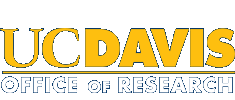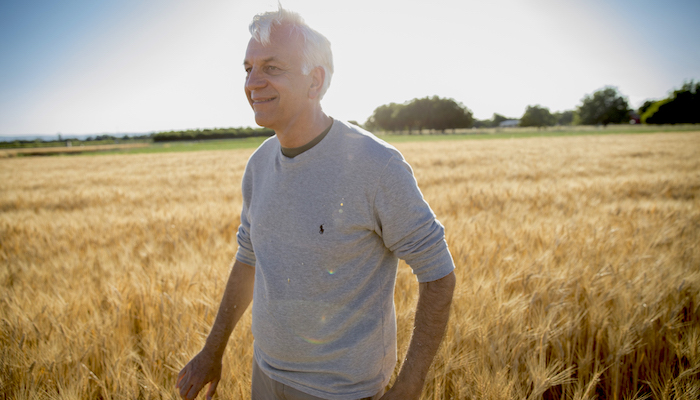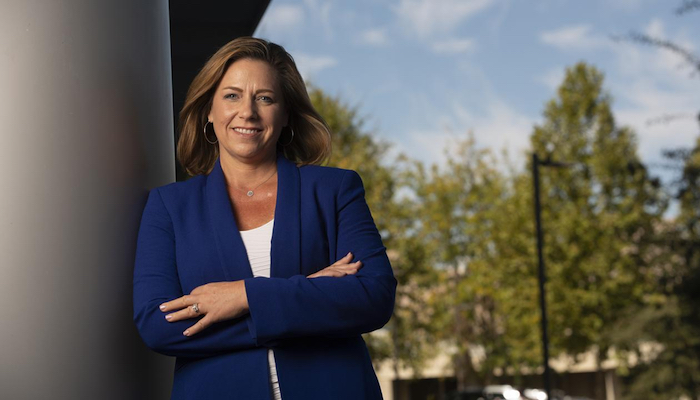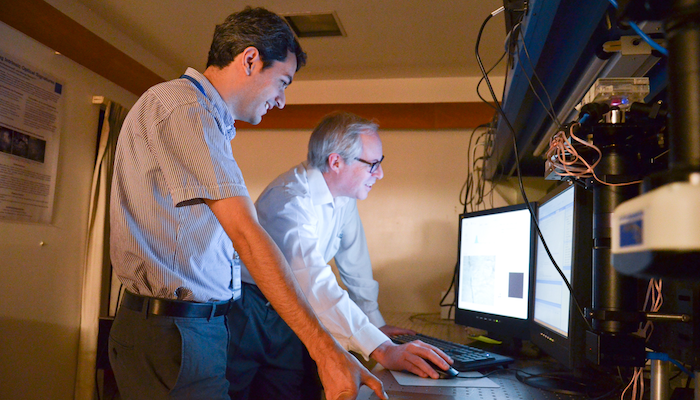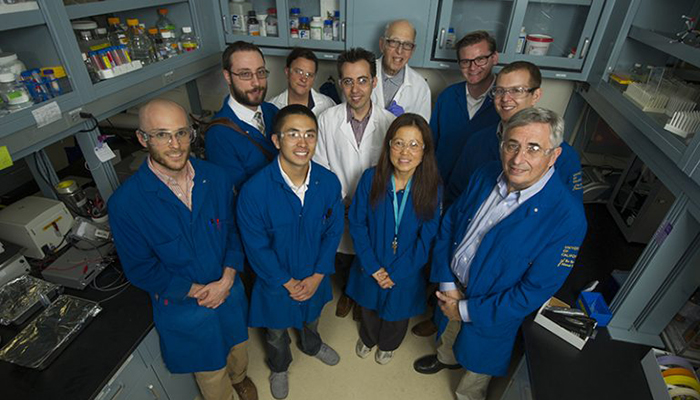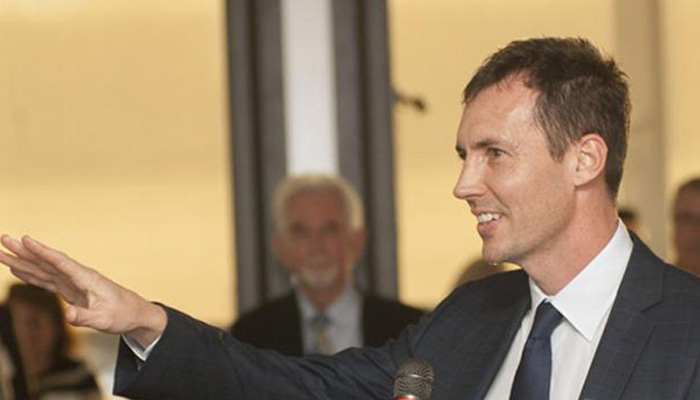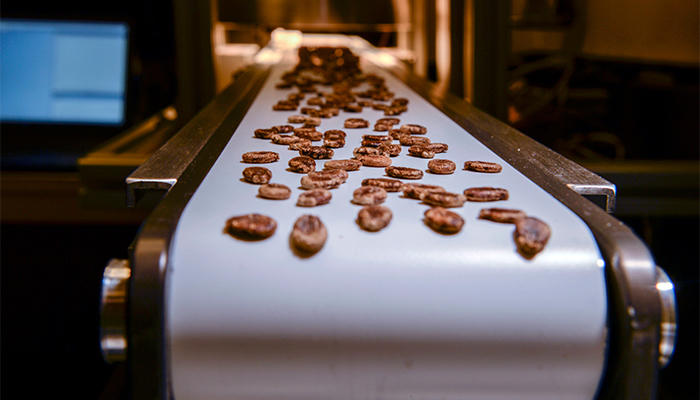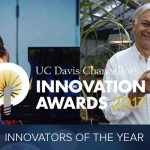Amber Waves of Genetic Wheat Mutations: Developing Better Wheat to Feed the World
By Lisa Howard
Jorge Dubcovsky, a world-renowned wheat breeder and geneticist, says he is not a romantic when it comes to the visual appeal of a wheat field, not even when it is bathed in the golden light of a California sunset.
“You know those old paintings that show these beautiful wheat fields with waving spikes? Wheat fields are actually very itchy. They’re not that friendly to work in,” said Dubcovsky. “But in the past people would look at a wheat field like this one and know they would not go hungry over the next winter. So, the image of a good wheat field is important in our culture.”
Wheat varieties and breeding lines developed by Dubcovsky’s lab are being grown in arguably beautiful straw-colored fields just west of Highway 113 in Davis where the freeway curves onto eastbound Interstate 80. There is a steady hum from the traffic. Watchful red-winged blackbirds balance on the ends of swaying wheat spikes, trilling out quick, individual calls. “Their nests are in the wheat straw,” said Dubcovsky.
Different plots have staked signs with names like “Patwin-515HP,” “Lassik,” and “Desert King-HP.” To the untrained eye, much of the wheat looks generally similar — some taller, some shorter — but each cultivar has unique characteristics as a result of the lab’s breeding program. Patwin-515HP is a hard-white spring wheat resistant to a pathogen called stripe rust and with high protein. Lassik is a hard-red spring wheat that is resistant to rust and to a disease known as barley yellow dwarf virus.
Dubcovsky, originally from Argentina, is a distinguished professor in the Department of Plant Sciences and a Howard Hughes Medical Institute researcher at UC Davis. He is genial and energetic. He pulls off a seed head and then quickly rubs his hands together to remove the seeds from the chaff. He blows on his hands to remove the rest of the chaff and then holds out a small handful of tan wheat grains for examination. “You are hungry? It is ready for harvest,” he said.
Dubcovsky has been studying grasses — wheat is a type of grass — for decades. When he was pursuing his Ph.D. in biological sciences at the University of Buenos Aires in the late 1980s, he began collecting and studying different species of wild South American grasses. After receiving his Ph.D., he took a fellowship at UC Davis where he spent three years as a visiting scientist, working with Jan Dvorak, a pioneer in the field of wheat genomics.
Dubcovsky credits Dvorak with providing the foundation for his research into wheat genetics. “He was really instrumental for me and it was a really exciting time. There were a lot of questions that were ripe to be answered, and we had the molecular tools for the first time,” said Dubcovsky.
He moved back to Argentina briefly, but then returned to UC Davis in 1996 and joined the faculty as an assistant professor in the Department of Agronomy and Range Science that later merged with other three departments to form the large Department of Plant Sciences in 2003.
The goal of his research, Dubcovsky said, is simple. “We want to make better wheats.”
For the past five years, Dubcovsky and the students in his lab have pursued the goal of better wheat by working on a technology that allows them to sequence all the genes of wheat and to find all the mutations — genetic variations — in their mutant wheat populations. The result is a database containing more than 10 million mutations distributed in roughly 100,000 wheat genes.
The potential of the tool is enormous. “There are millions of applications,” said Dubcovsky. “We can find mutations on any gene that we want to study their function.”
One of the first things his lab did with their new tool was to develop a variety of wheat that contains 10 times the amount of dietary fiber. What is unique about this wheat variety is that the fiber is in the starch itself, which means a loaf of white bread made from these varieties could potentially have as much fiber as a whole-wheat loaf.
The specific impact of the research informs how Dubcovsky thinks about the different varieties. For example, he notes this type of high-fiber wheat would mainly be for “people who have too much food.” Countries with high rates of obesity and diabetes might be the most interested and see the most health benefits.
“For people who do not have enough food you work on other genetic traits — productivity, and increased nutrients like protein, iron and zinc. There are different objectives for different places and people,” said Dubcovsky, who won the Wolf Prize in agriculture for his discovery of a gene that significantly increases these nutrients in the wheat grain.
How to meet the dietary needs of a growing global population is a huge consideration for wheat researchers. Annually, the yield of wheat has increased about 1 percent a year, but that will likely not be enough to keep up with the anticipated 1 billion more people — about 8.5 billion — expected to be on the planet by 2030.
Dubcovsky has global wheat stats at the ready. “Wheat provides 20 percent of the calories and 23 percent of the protein consumed by humans. More than 700 million tons of wheat are produced worldwide each year,” he said.
The sheer volume of wheat produced around the world means even small variations in things like disease resistance, nutrition and drought tolerance, can be extremely significant.
“Every small improvement you can make in wheat can have an important impact in the life of a lot of people,” said Dubcovsky.
And with the new tool he’s created, pursuing those improvements will be significantly faster and easier for wheat breeders.
Researchers can search his lab’s public database of 10 million genetic mutations and order seeds with specific genetic mutations. More than 3,000 of these seed stocks have already been distributed to wheat researchers around the world.
Dubcovsky considers research critical to the threats against food security. As an example, he describes a pathogen, rust, which destroyed a significant amount of the wheat crop in California several years ago.
“There was already a lot of research in place. Immediately we have genes that were resistant, so we were able to map those genes and use molecular markers to deploy them faster into our varieties. In this time of climate change, you need to be able to respond fast. Without research, it’s difficult to do it.”
But Dubcovsky also notes that solving a problem once won’t be enough. “Pathogens continue to evolve and we need to develop new resistance. We are permanently fighting pathogens that also want to eat the wheat we produce,” he said.
Dubcovsky’s lab and growth chambers in Robbins Hall are clean and large, and as active as the wheat fields. Although there are no birdsongs or wind, several students and postdocs move under the overhead fluorescent lights and among the bank of tall indoor growth chambers. Inside each chamber, different wheat varieties that may eventually end up in the fields are being grown in square, black, plastic pots under artificial light. In a smaller room off the main room, green seedlings about 5 inches tall are getting their start hydroponically, their pale, white roots dangling into a nutrient bath. Some of these very plants may deliver on the promise of developing better wheat.
In June, Dubcovsky’s accomplishments were recognized when he received the 2017 UC Davis Innovator of the year Award, which recognizes individual faculty, staff or teams whose inventive, innovative or entrepreneurial activities have had a measurable societal impact or the strong potential to do so.
Dubcovsky’s global reach can not only be measured by the new genomic tool he’s developed but also by his students.
A world map in the hallway near his lab is covered in stickers to show where all the students and postdocs are from. “We have students from all over,” he said gesturing to different regions. “From America, South America, Asia, Africa and Australia. Wheat is eaten around the world.” He enjoys working with students. “It’s a privilege. You are with clever young people who are energetic all the time, giving you input and energy,” he said.
“What keeps me inspired is the sense that my work is meaningful, that I’m doing something that will be helpful for a lot of people, that I’m making something with my life that will help other human beings. It’s a fantastic job,” said Dubcovsky.
Media contact
Lisa Howard, UC Davis Office of Research, 530-752-8117, [email protected]
Media Resources
Dubcovsky Lab
UC Davis Chancellor’s Innovation Awards
Engineers, Painter First Recipients of Innovation Awards
Poet, Software Pioneer Receive UC Davis Innovation Awards
Latest News & Events
